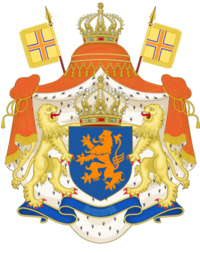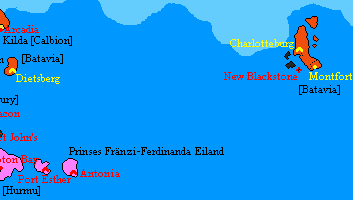Treaty between Batavia and Hurmu
The Treaty of friendship and cooperation between the Kingdom of Batavia and Hurmu was signed and ratified in 1702 AN. Following Batavia's accession to Shireroth, the treaty is valid only insofar that it does not conflict with any other agreements between Hurmu and Shireroth.
Text
TREATY OF FRIENDSHIP AND COOPERATIONBETWEEN
THE KINGDOM OF BATAVIA
AND
HURMU
It being of great advantage to establish relations of friendship and commerce between the countries under the Senate of the Lakes and His Majesty the King of Batavia, the undersigned, having exchanged their powers, mutually admitted as sufficient, have agreed, on the part of their respective Sovereigns, to conclude a Treaty of Friendship and Cooperation, as follows:Article I – Peace and friendship
There shall be a firm and perpetual state of peace and friendly relations between the Senate of the Lakes and His Majesty the King of Batavia, his heirs and successors, and between Hurmu and the Kingdom of Batavia, and between their Citizens, without discrimination.Article II - Sovereignty and territorial integrity
Each High Contracting Party shall respect the independence, sovereignty and territorial integrity of the other party. The High Contracting Parties shall continue to develop and consolidate the relations of sincere friendship, good neighbourliness and comprehensive cooperation existing between them on the basis of the aforesaid principles as well as those of equality and mutual benefit.Territorial integrity includes the territory of a High Contracting Party to the extent acknowledged and published by the Micronational Cartography Society. The territory extends 24 kilometres from the baseline coast of the High Contracting Party. Including the localities where the coastline is deeply indented and cut into, or if there is a fringe of islands along the coast in its immediate vicinity, the method of straight baselines joining appropriate points may be employed in drawing the baseline from which the breadth of the territorial sea is measured.
The reserve zone of a High Contracting Party extends 360 kilometres from the baseline coast. The economic and environmental resources within this zone belong fully to that High Contracting Party. In special situations where the territorial waters or the reserve zone of the High Contracting Parties would overlap, the line of separation will be drawn along the midpoint between the baseline of each High Contracting Party.
Article III - Airspace
Each High Contracting Party commits that any overflight of its airspace by civilian or commercial aircraft registered upon the territory of the Other High Contracting Party, whose source and destination are outside the jurisdiction of the Overflown High Contracting Party and which make no intermediate landing upon the territory of the Overflown High Contracting Party, shall be considered to fall outside the remit of customs or immigration regulations and wholly outside the jurisdiction of any Third Parties, without prejudice to the exclusive right of the Overflown High Contracting Party to approve or deny such overflight as it sees fit.The High Contracting Party can set up a Prohibited airspace, an overflight is strictly prohibited. The High Contracting Party informs about Prohibited airspace and appropriate punitive measures follow an overflight of an aircraft registered with the other High Contracting Party.
Article IV – Diplomatic mission
The High Contracting Parties will maintain regular contacts with each other on major international problems affecting the interests of both of their countries and governments by means of meetings, and exchanges of views between their leading statesmen, visits by official delegations and special envoys of the governments, and through diplomatic channels.The High Contracting Party will make an embassy available for each other.
For the embassy, associated grounds, associated vehicles, leading statesmen, visits by official delegations, special envoys of the governments and ambassadors, diplomatic immunity applies.
Each High Contracting party recognizes and respects the procedures of acceptance by the ambassador, by handing over a letter of credence, which is addressed from one head of state to the other asking to give credence.
Article V - Recognition of bureaucracy
Each High Contracting Party gives to the other full faith and credit to all public acts, records, contracts and judicial proceedings in the field of civil law, including records and documents on marriage, property, titles, death and inheritance, in as much as any act, record, document, contract, proceeding is done according to the law.Article VI - Landtransfer
The High Contracting Parties agree to a landtransfer:
a. Hurmu ceding sovereignty over Northern Bretland to the Kingdom of Batavia.
b. Kingdom of Batavia ceding sovereignty over Princess Fränzi Ferdinanda Island to Hurmu.Article VII - Interpretation
Any difference of interpretation of any Article or Articles of this Treaty which may arise between the High Contracting Parties will be settled bilaterally by peaceful means in a spirit of mutual respect and understanding.Article VIII - Ratification
This Treaty enters into force upon its signature and ratification by Both High Contracting Parties in accordance with their respective domestic procedures.
Signed on 11.VI.1702 AN:For the Kingdom of Batavia:
- Hendrik Leopold des Vinandy
- King of Batavia
For the Senate of the Lakes:
- Karel Kyle des Vinandy
- Senator
Map


